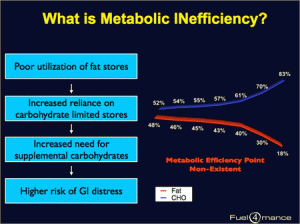[podcast src=”https://html5-player.libsyn.com/embed/episode/id/4817201/height/90/width/480/theme/custom/autonext/no/thumbnail/yes/autoplay/no/preload/no/no_addthis/no/direction/forward/render-playlist/no/custom-color/88AA3C/” height=”90″ width=”480″] Coach BK and Bob Seehohar, author of the fantastic book, Metabolic Efficiency training chat why it is so important to become more FAT ADAPTED.
Coach BK and Bob Seehohar, author of the fantastic book, Metabolic Efficiency training chat why it is so important to become more FAT ADAPTED.
Part 2 will contain more information on the eating strategies included in the book.
CLICK here >>> for a Free Athlete Health Assessment with Coach BK to fill out an online form and chat with her on the phone for 30 about where you are right now as a person and athlete. Health Assessment
More information on Metabolic Efficiency here >>> Metabolic Efficiency
MORE ABOUT THE ENERGY SYSTEMS OF THE BODY
Three different metabolic energy systems power your workouts — and your day. Here’s how each one works, and how to make the most of them all.
Your body has several ways of turning the stuff you eat into the stuff you do. All of these metabolic energy systems are switched on during physical activity, but each plays a different role depending on available energy and the specific demands of the task. Each burns a particular type of fuel at a particular rate — thereby affecting fat loss and muscle gain in a particular way.
- The adenosine triphosphate–creatine phosphate (ATP-CP) system, or phosphagen system, supports very brief, high-intensity activities like a single-effort vertical jump.
- The glycolytic system provides energy for activities of slightly longer duration and lower intensity like strength training.
- The oxidative system supports long-duration, lower-intensity activities like walking or distance running.
>>> READ MORE
